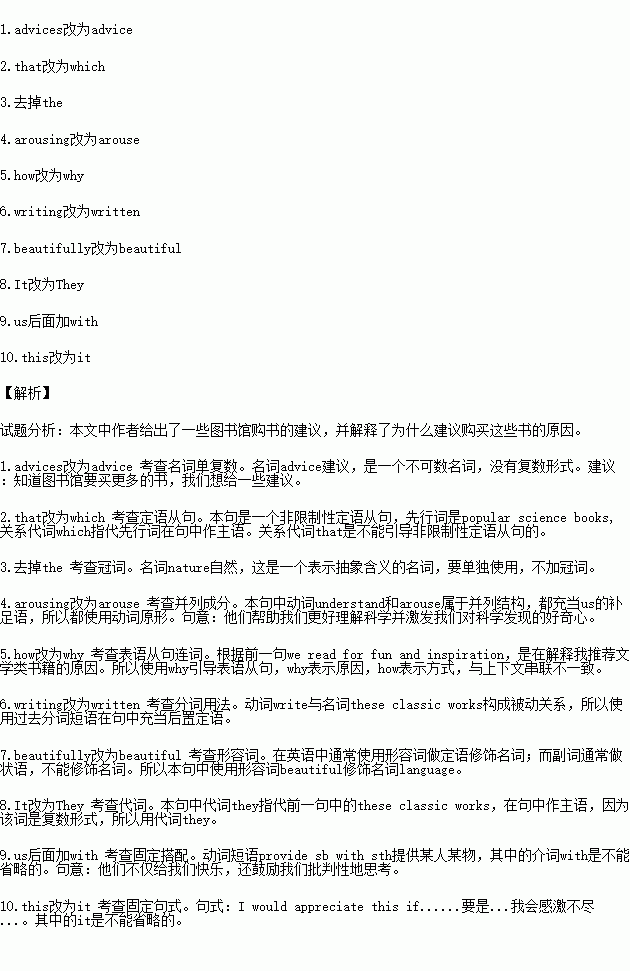ĚâÄżÄÚČÝ
¶ĚÎĸĴí
ĽŮ¶¨Ó˘ÓďżÎÉĎŔĎʦҪÇóͬ×ŔÖ®Ľä˝»»»Đ޸Ä×÷ÎÄŁ¬ÇëÄăĐ޸ÄÄăͬ×ŔĐ´µÄŇÔĎÂ×÷ÎġŁ
ÎÄÖĐą˛ÓĐ10´¦ÓďŃÔ´íÎóŁ¬ĂżľäÖĐ×î¶ŕÓĐÁ˝´¦ˇŁĂż´¦´íÎó˝öÉ漰һ¸öµĄ´ĘµÄÔöĽÓˇ˘Éľłý»ňĐ޸ġŁ
ÔöĽÓŁşÔÚȱ´Ę´¦ĽÓŇ»¸ö©×Ö·űşĹŁ¨ Ł©Ł¬˛˘ÔÚĆäĎÂĂćĐ´łö¸ĂĽÓµÄ´ĘˇŁ
Ł©Ł¬˛˘ÔÚĆäĎÂĂćĐ´łö¸ĂĽÓµÄ´ĘˇŁ
ÉľłýŁş°Ń¶ŕÓŕµÄ´ĘÓĂбĎߣ¨ŁÜŁ©»®µôˇŁ
Đ޸ģşÔÚ´íµÄ´ĘĎÂĂćŇ»şáĎߣ¬˛˘ÔڸôĘĎÂĂćĐ´łöĐ޸ĺóµÄ´ĘˇŁ
עŇ⣺1.Ăż´¦´íÎóĽ°ĆäĐ޸ľů˝öĎŢŇ»´ĘŁş
2Ł®Ö»ÔĘĐíĐ޸Ä10´¦Ł¬¶ŕŐߣ¨´ÓµÚ11´¦Ć𣩲»ĽĆ·ÖˇŁ
Dear Sir or Madam,
Knowing that our library is going to buy more books, IˇŻd like to give some advices.
What we need most are popular science books, that usually explain basic principles of the nature in a simple and interesting way. They help us understand science subjects better and arousing our curiosity about scientific discoveries.
In addition to reading for knowledge, we read for fun and inspiration. That is how I recommend another category of books: literary books. These classic works, writing by great masters , present noble thoughts through fascinating stories and beautifully language. It not only provide us joy and excitement, but also encourage us to think critically.
I would appreciate this if you could consider my recommendation.
Yours sincerely,
Li Hua
 ×Ö´ĘľäĆŞÓëͬ˛˝×÷ÎÄ´ď±ęϵÁĐ´đ°¸
×Ö´ĘľäĆŞÓëͬ˛˝×÷ÎÄ´ď±ęϵÁĐ´đ°¸The Metropolitan Museum of Art (Met) is one of the worldˇŻs largest and finest art museums. Following the suggested route will help you explore the museum.
The Temple of Dendur
This 2000-year-old building stood near the Nile River, surrounded by a wall that no longer exists. But you can still peek through the gateway. Whose ˇ°houseˇ± is this? It's not for people. ItˇŻs for gods. Can you identify them? They face out. A king faces in, bringing offerings.
MetSpeaks
Bringing together some of the most respected thinkers on a given subject, MetSpeaks features lectures, discussions, talks, films, and forums in which compelling voices explore timely issues that connect to the MetˇŻs exhibitions and permanent collection. Program times, audiences, and topics vary.
Time to Sketch
Settle down for a few minutes, pick something in this gallery, and have fun drawing it. Enjoy the chance to look carefully as you create your own sketch. You'll be surprised at how much more you notice, thanks to exploring art by sketching.
MetAccess
Make the Met yours! Choose from a variety of services and exciting programs that are tailored to meet the needs of visitors with disabilities. Program times, audiences, and topics vary.
Ask for the Access Information brochure and Access Calendar at Information Desks, download the Access Calendar (PDF), or call 212-650-2010 or email access@metmuseum.org.
Admission
Fee includes admission to the Main Building and same-week admission to the Cloisters museum and gardens.
Recommended | Fee |
Adults | $25 |
Seniors (65 and older) | $17 |
Students | $12 |
Members (Join Now) | Free |
Children under 12 (accompanied by an adult) | Free |
1.How much is recommended to pay for 3 adult and 2 student visitors?
A. 99 B. 111 C. 87 D. 103
2.What can you know about the Temple of Dendur?
A. A high wall is surrounding the 2000-year-old building now.
B. A king faces out, bringing offerings in the temple.
C. The building is designed for Emperor to live in.
D. The Nile River witnessed the history of the building.
3.Which of the following is TRUE about the Met?
A. Issues connected with economic crisis will be discussed in MetSpeaks.
B. Visitors can choose something in the gallery and have fun drawing it on the wall.
C. Disabled people will find various services and programs offered especially for them.
D. You can email access@metmuseum.org for more Admission information.

